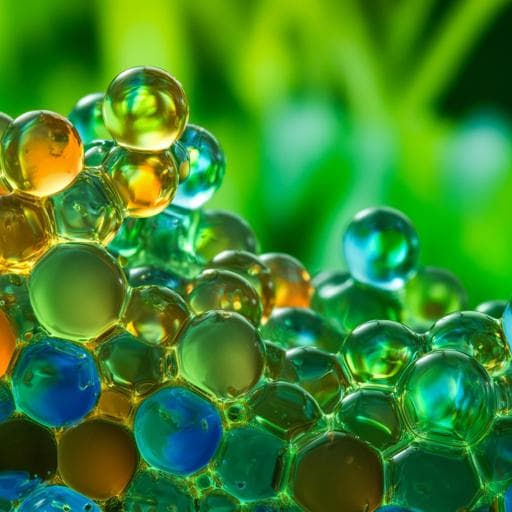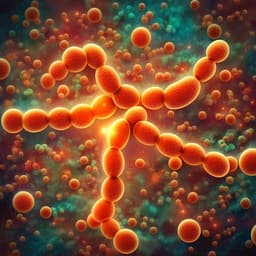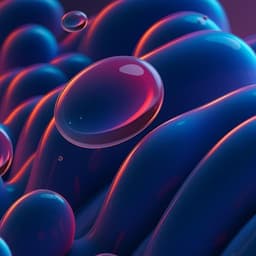
Food Science and Technology
Transforming sustainable plant proteins into high-performance lubricating microgels
B. Kew, M. Holmes, et al.
Discover how researchers Ben Kew, Melvin Holmes, Evangelos Liamas, Rammile Ettelaie, Simon D. Connell, Daniele Dini, and Anwesha Sarkar have transformed plant proteins into microgels, enhancing their lubricity and reducing friction significantly compared to traditional proteins. This innovative advancement could pave the way for healthier and more appealing food options, all while supporting sustainability.
~3 min • Beginner • English
Introduction
The study addresses a key barrier to widespread adoption of plant proteins: their negative astringent, dry mouthfeel linked to high friction and poor lubrication in the oral environment. Plant proteins often aggregate, jam, and interact unfavorably with saliva, increasing oral friction compared with dairy proteins. Given the urgent need to transition to plant-based diets to reduce greenhouse gas emissions, improving the sensorial functionality of plant proteins is critical. Prior work shows fat coalescence confers desirable creamy, low-friction mouthfeel, whereas non-lipidic fat mimetics can rely on hydration lubrication or ball-bearing mechanisms. Protein microgels have emerged as promising fat mimetics, but studies largely focus on dairy proteins; plant proteins also suffer from variability in solubility and functionality. The central hypothesis is that transforming plant proteins into physically cross-linked microgels can markedly improve lubricity and potentially emulate oil-in-water emulsion lubrication without added lipids.
Literature Review
- Oral tribology correlates friction with sensory attributes such as smoothness and creaminess; plant proteins are known to increase friction due to aggregation and interactions with saliva.
- Protein microgels (e.g., whey, carrageenan, synthetic) have shown enhanced lubrication dependent on particle volume fraction and elasticity; mechanisms include viscosity-induced separation, hydration lubrication, and debated ball-bearing effects.
- Prior fat-mimetic work emphasizes dairy proteins; plant proteins remain underexplored and present challenges (limited solubility, heterogeneity, poor hydration), necessitating new structuring strategies such as microgelation.
- Biomimetic tongue-like surfaces have been proposed to improve in vitro prediction of in vivo mouthfeel compared with conventional smooth PDMS tribopairs.
- Lubrication modeling commonly uses Stribeck-type approaches; alternative empirical formulations can capture boundary-to-EHL transitions for complex fluids like microgel dispersions.
Methodology
- Materials: Pea protein concentrate (PPC, 85% protein) and potato protein isolate (PoPI, 91% protein) were used to fabricate microgels. A 20:80 oil-in-water (O/W) sunflower oil emulsion stabilized with potato protein served as a high-lubricity control.
- Microgel fabrication: Top-down approach via thermal gelation and physical crosslinking followed by homogenization. Protein solutions (PPC 15.0 wt%; PoPI 5.0 and 10.0 wt%; mixed PPC 7.5 wt% + PoPI 5.0 wt%) were prepared in 20 mM HEPES pH 7.0, heated at 80 °C for 30 min, cooled, stored overnight at 4 °C to form hydrogels, then mechanically broken and high-pressure homogenized (two-stage, 250/50 bar; three passes) to yield microgels. Samples: PPM15, PoPM5, PoPM10, PPM7.5:PoPM5. Volume fractions Φ adjusted to 10–70 vol% by dilution.
- Particle sizing and stability: Dynamic light scattering (DLS) at 25 °C measured hydrodynamic diameters and PDI. Stability was assessed over 28 days at 22 °C and after thermal processing (90 °C, 30 min). AFM imaging of hydrated microgels on silicon in buffer determined morphology and size distributions.
- Rheology: Parent gels characterized by oscillatory shear (G', G'') and temperature ramps; Young’s modulus measured via large deformation compression. Microgel dispersions (Φ = 10–70%) assessed for flow behavior at 37 °C across shear rates 1–1000 s⁻¹; apparent viscosities reported at 0.1 s⁻¹ and 50 s⁻¹.
- Tribology (PDMS-steel): Steel ball on PDMS pins at 37 °C, normal load 2 N. Friction coefficient μ measured across entrainment speeds, with μ plotted against U scaled by high-shear viscosity at 1000 s⁻¹ to construct Stribeck-like curves. Comparators included native proteins (matched protein content to Φ = 70%) and 20 wt% O/W emulsion; buffer as control. Load-dependence (2–10 N) assessed for selected samples.
- Tribology (biomimetic tongue-steel): Tests on a 3D-printed, tongue-like, hydrophilic elastomeric surface mimicking human tongue papillae topology, wetting, and elasticity; plate-on-plate geometry at 1 N normal force, reporting μ vs linear speed (boundary-focused analysis).
- Adsorption (QCM-D): PDMS-coated sensors exposed to 1 vol% microgel dispersions to quantify hydrated mass and viscoelasticity (−ΔD/Δf) and assess adsorption/swelling behavior before and after buffer rinsing.
- Theoretical modeling: Alternatives to classical Stribeck models using empirical Gompertz-type relations to fit μ vs log U; Hertzian contact analyses to estimate microgel indentation, load sharing, and drag force (Stokes) to rationalize entrainment and lubrication mechanisms.
Key Findings
- Microgel structure and stability: Sub-micron, soft, spherical microgels formed across all systems. DLS hydrodynamic diameters: PoPM5 ~67 nm; PoPM10 ~132 nm; PPM15 ~204 nm; mixed PPM7.5:PoPM5 showed bimodal populations (~<100 nm and larger), reflecting separate formation by pea and potato proteins. AFM sizes agreed in general, with differences attributed to hydration shells affecting DLS. Microgels were stable with no sedimentation over ≥28 days and thermally robust (90 °C, 30 min) with minimal changes in size.
- Rheology: Most microgel dispersions exhibited near-Newtonian behavior, with shear thinning emerging at high Φ (60–70%). Apparent viscosity increased with Φ, particularly for PoPM10 (higher modulus gel). PPM15, despite highest protein content, showed lower gel modulus and comparatively low viscosity, reflecting pea protein’s limited solubility and gelation efficacy.
- Tribology (PDMS-steel Stribeck): Microgels entered mixed lubrication at very low speed×viscosity (~0.04 Pa·m), indicating ultra-lubricating behavior. At 0.1 Pa·m, microgels significantly outperformed native proteins (p<0.01), achieving ≥5× reductions; PPM15 achieved >10× reduction (μ≈0.006–0.01 vs native μ≈0.14). Microgels at Φ=10–40% matched or outperformed O/W emulsion (μ≈0.03 at 0.1 Pa·m). Lowest μ observed: PPM15 at Φ=10% reached μ≈0.0057 at 0.1 Pa·m. Buffer μ≈0.74 at 0.1 Pa·m. At Φ=70%, most microgels achieved μ≈0.01, except PoPM10 (μ≈0.035) attributed to high viscosity and jamming.
- Load dependence: Across 2–10 N, microgels maintained low friction without converging toward native protein behavior, suggesting robust load support and resilience.
- Tribology (biomimetic tongue): Microgels generally matched O/W emulsion’s low boundary friction across conditions; some cases (PoPM5 Φ=10%, PoPM10 Φ=10%, PPM7.5:PoPM5 Φ=70%) showed higher μ at low speeds, likely due to insufficient entrainment or jamming at papillae. At higher speeds, μ differences vs O/W emulsion were non-significant.
- Adsorption (QCM-D): Hydrated masses differed among microgels (e.g., PoPM10 highest), broadly correlating with gel modulus; viscoelasticity (−ΔD/Δf ~0.08–0.12) similar among microgels. PPM15’s hydrated mass and viscoelasticity resembled native pea protein, but buffer rinsing indicated swelling and reduced binding, consistent with improved lubricity.
- Mechanism and modeling: Empirical Gompertz-type fits captured μ–U behavior. Hertzian analysis indicated microgels support >90% of the load and deform substantially (SR*>1), acting as water reservoirs that weep under load to increase local viscosity and provide hydration lubrication. Compared with O/W emulsions (elliptically deforming droplets, SR*<1), microgels achieved similar macroscopic lubricity via different micro-mechanisms.
- Sustainability context: Microgelation uses standard food processing steps; LCA proxies suggest processing energy impacts are minor relative to raw material production. Enhanced lubricity without lipids could enable more acceptable, lower-impact plant-based foods.
Discussion
Transforming plant proteins into physically cross-linked microgels effectively addresses the high-friction, astringent mouthfeel associated with native plant proteins. Across pea, potato, and mixed systems, microgels standardize particle size, suppress aggregation, and deliver ultra-low friction comparable to a 20:80 O/W emulsion without added lipids. The lubrication advantages persist across volume fractions and normal loads, demonstrating robustness. Mechanistically, microgels’ soft, hydrated nature enables deformation, surface separation, and hydration lubrication by releasing water into the contact and forming hydrated, steric layers. Modeling with an empirical Gompertz-type relation captures the transition from boundary to mixed and EHL regimes, aligning with the notion of an increasing effective fluid height under shear/entrainment. Results on the biomimetic tongue surface confirm in vitro mouthfeel relevance while revealing surface topology-dependent behaviors (e.g., jamming at high Φ for mixed microgels), underscoring the need for realistic test surfaces in soft-tribology. Collectively, the findings demonstrate a feasible, additive-free strategy to endow plant proteins with high-performance lubrication, directly tackling the sensory barrier to broader plant-protein adoption.
Conclusion
This work demonstrates that microgelation of plant proteins yields stable, sub-micron, physically cross-linked particles that dramatically reduce friction—by up to an order of magnitude relative to native proteins—and emulate the lubricity of 20:80 oil-in-water emulsions without lipids. Through comprehensive characterization (DLS, AFM, rheology, tribology on PDMS-steel and biomimetic tongue-steel), adsorption studies (QCM-D), and theoretical modeling, the study elucidates a hydration-lubrication mechanism in which deformable, water-rich microgels act as load-bearing, fluid-releasing reservoirs. These insights provide a platform for designing healthy, palatable, and sustainable plant-protein foods, potentially accelerating dietary shifts away from animal proteins. Future work should integrate sensory evaluations to validate in vitro–in vivo correlations, optimize microgel formulations across broader plant protein sources, and include process-scale LCA to quantify environmental benefits of microgelation at industrial scale.
Limitations
- Sensory validation was not conducted; in vitro friction–mouthfeel correlations, though well-supported in literature, need direct sensory confirmation for these microgels.
- Life cycle assessment of the microgelation process was not performed; only proxy comparisons to other processing steps were discussed.
- Some conditions on the biomimetic tongue surface showed increased friction (e.g., PoPM5 and PoPM10 at low Φ, mixed microgels at high Φ), likely due to jamming at papillae, indicating topology- and concentration-dependent behavior.
- Plant protein variability (solubility, functionality) may affect gelation and microgel properties; scalability and standardization across raw materials require further investigation.
Related Publications
Explore these studies to deepen your understanding of the subject.







